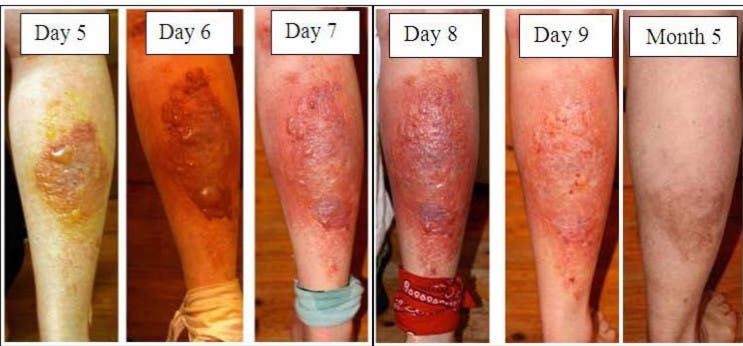
An invasive plant that can cause horrible third-degree burns if you so much as brush against its bristles has been spotted for the first in the state of Virginia.
Last week, state officials reported the first sighting of the giant hogweed (Heracleum mantegazzianum). About 30 of these towering plants have been found in Clarke County, and locals are warned to keep an eye out for sightings. The plant — native to the Caucasus — region looks rather benign, however, it’s anything but.
Today I helped ID VA’s first giant hogweed population! Its sap causes severe burns. One plant was found in Clarke County. Report sightings to your extension agent! ID help: https://t.co/VMkYqyaccB Thanks to @herbariumkeeper and @VTAgWeeds for ID help and report! pic.twitter.com/4BM9RhyMem
— Jordan Metzgar (@MasseyHerbarium) June 12, 2018
The giant hogweed poses a serious human health hazard because it exudes a clear watery sap containing photosensitizing agents. The phototoxic chemicals, known as furanocoumarins, are highly reactive to UV light, causing severe burns and blistering.
Coming into contact with hogweed can be a traumatic experience. The light-sensitive skin reaction causes dark painful blisters that form within 48 hours, and result in scars that can last anywhere from a few months to six years. Touching giant hogweed can also make you sensitive to sunlight and cause blindness if sap gets into a person’s eye.
The invasive plants also pose an ecological threat, forming tall, dense, and deeply shaded stands that push back the growth of native species. What’s more, during winter months, the soil under the giant hogweed becomes bare and erodes more readily.
The Giant Hogweed is currently listed on the Virginia Invasive Plants Early Detection Species list, which means that the plant is not widely established in the state but is known to spread in similar habitats to Virginia’s. According to the DEC, the toxic plant grows in New York, Pennsylvania, Ohio, Maryland, Oregon, Washington, Michigan, Vermont, New Hampshire and Maine. The invasive plant arrived in North America in the mid-19th century.

[panel style=”panel-warning” title=”What to do if you touch a giant hogweed plant?” footer=””]If you accidentally come in contact with sap from the giant hogweed plant, doctors recommend that you wash it off immediately with cold water. The toxic reaction can begin as soon as 15 minutes after coming into contact with the toxic photochemicals, so you must get out of the sun.
Apply sunscreen to the affected areas if you have some at your disposal. A towel or compress soaked in aluminum acetate, which you can purchase from pharmacies, provides temporary relief for skin irritations.
If Hogweed sap gets into the eye, rinse them with water immediately and put on sunglasses.
If you experience severe reactions, visit a doctor immediately. [/panel]
Besides being incredibly dangerous, the giant hogweed is also very resilient. Each plant can shed thousands of seeds which remain viable in the soil for years.
If you live near a giant hogweed, don’t try to mow or weed-whack the plant. This will only promote more growth and potentially expose you to the toxic chemicals. Instead, immediately call local authorities and ask for professional help.


